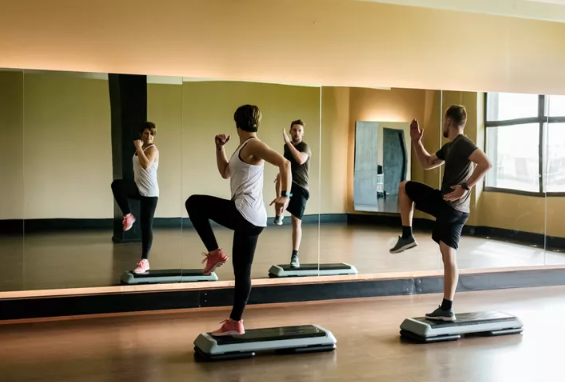Health Benefits of Step Workouts

A step workout is a cardio exercise that utilizes a raised platform to step on and off while exercising. Sometimes, the platform can be raised higher as your fitness improves to provide a harder workout. It can also be low (for example, for beginners or people with more limited mobility).
Originally called step aerobics, step workouts were created by Gin Miller, an aerobics instructor who started using her porch steps as a form of rehab after a knee injury. Once she realized that “stepping” provided a good aerobic workout for her heart, she began introducing the concept of step aerobics everywhere that she taught fitness classes.1
Although interest in step aerobics decreased somewhat since Miller first introduced it, it has started making a comeback recently—especially because of its many associated health benefits, including improvements in heart health, mood, balance, strength, and functional abilities. It’s also accessible to people of all ages and fitness levels.
Strengthens and Builds Bone
Step workouts are low-impact, weight-bearing activities that can be ideal for your bone health, particularly for more mature adults and those about to enter menopause. Research shows that regular step training can improve bone metabolism—or the growth of new bone—in postmenopausal people.2
One study found that six months of step workouts increased bone density in premenopausal people more than resistance training did.3 This means that adding a step workout to your regular workout routine could support your bone health.
Supports Cognitive Health
Step workouts require concentration, especially if you’re working out to a video at home or in a class at the local community center. If you don’t focus, you may not know what’s coming next or you may trip or stumble through the moves. This type of focus can support cognitive health.
Researchers have found that performing specific, choreographed moves—like those in treadmill walking and ballroom dancing—can improve your executive functioning and processing speed. Step workouts involve choreographed moves done to music.4 In addition, countless studies show that exercise, in general, can improve working memory, inhibition, cognitive flexibility, and more.5
Improves Functional Ability
Many people lose muscle mass and strength as they age. By the age of 50, muscle strength decreases at a rate of approximately 12-15% per decade. This loss in muscle and strength can affect functional ability and make it more difficult to perform everyday activities like climbing stairs, rising from a chair, and doing household tasks. Research has found that step workouts can help combat this decline.6
One small study of older women found that a regular step workout performed at home while wearing a weighted vest improved lower body muscle power and functional ability by approximately 10%. Researchers theorize that step training could help older adults, particularly women, maintain their independence by almost 10 years.6
Boosts Heart Health
Almost half of all adults in the United States have at least one risk factor for heart disease such as smoking, hypertension (high blood pressure), high cholesterol, or a sedentary lifestyle. However, research consistently shows that regular aerobic exercise, like step workouts, can reduce the risk of heart disease and boost heart health.7
Plus, some exercise experts indicate that a one-hour step workout uses the same energy expenditure as running seven miles—without all of the impact.1 Consequently, people use step workouts to continue building their cardiovascular health when recovering from an injury or as a cross-training tool on their recovery days.
Increases Longevity
Taking steps is one of the key components of a step workout, which can do much more than tally up additional movement on your fitness tracker. It may actually help you live longer.
Researchers have found that people who took 8,000 steps a day had a 50% lower risk of dying from any cause, and those who took 12,000 steps a day had a 65% lower risk of dying than those who only took 4,000 steps a day. They also found that higher step counts correlated with lower rates of death from cancer and heart disease.8
Lowers Blood Pressure
The risk of having high blood pressure increases with age. However, researchers have found that consistently completing step workouts may help reduce blood pressure without medication. In a randomized control trial of older adults with stage 1 hypertension—a blood pressure reading between 130/80 and 140/90 millimeters of mercury (mm Hg)—the participants completed moderate-intensity step workouts three times per week over an eight-week period.
At the end of the study period, the researchers found that step workouts helped significantly reduce blood pressure. Participants’ systolic blood pressure declined by more than 10 mmHg. Consequently, the researchers theorize that step workouts are an effective non-pharmacological intervention for blood pressure control.9
Improves Balance
As people age, the risk of falling increases, especially if they no longer have good balance or lower body strength. Step workouts may be able to combat that risk.
One team of researchers found that a progressive step marching exercise served as a good balance training program for older people. The program improved balance as well as lower body strength. It also increased the overall quality of life and reduced the fear of falling.10
How To Get Started
Step workouts have become a popular way to build fitness and add variety to workout regimens. In fact, exercise experts estimate that around 10 million people participate in step training.11 For this reason, finding step workouts online or at your local gym. Most people take a step workout class at their local gym, community center, or YMCA.
If you decide to do a step workout at home, you will need to purchase a step or platform. While it may be tempting to use your stairs at home, doing this on a regular basis could set you up for injury, especially if your heel hangs off or your foot is not all the way on the step. This can lead to achilles tendonitis. It could also pose a problem for your knees and put a lot of stress on the patellar tendon when done repeatedly.1
Step Exercises
Step workouts are a great way to work out your glutes (butt muscles) and hamstrings (backs of thighs) while also strengthening your core and building your cardiovascular fitness.
Here are a few step moves to practice at home with or without music. You can add these moves to another floor workout or do them alone.
Basic Up and Downs
Step up on your platform with your right foot and follow with your left foot. Then, step back down using your right foot, followed by your left foot. Once you have completed a few basic up and downs, switch feet and repeat.
Lateral Step-Ups
Stand to the side of your platform and step onto it with your right foot. Then, step with the left foot onto the platform. Return to the starting position by stepping back down to the opposite side and follow with the other foot. Once you have completed a few lateral step-ups, switch feet and repeat.
Step Lunges
Step onto your platform with one leg, keeping your other foot on the floor. Lower your body toward the floor until both knees form a 90-degree angle. Return to the starting position and step off the platform. Repeat with the other leg.
Step Knee Lifts
Step onto your platform with one leg and bring your other knee in close to your chest. Step back down and repeat with your other leg. Alternate knees for 60 to 90 seconds.
Step Over-the-Top
Step up sideways onto your platform with your right foot and then step up with the left. (You will be crossing over the long part of the platform or step.) Step off the other side of the step with the right foot and step down with the left foot. Tap, then cross back over the platform with the opposite foot leading.
Safety
Stepping on and off of a raised platform requires concentration, coordination, and balance, and if you are lacking these skills or simply unsure of yourself, you may be more prone to injury. According to experts, these risks can be minimized with a few safety precautions.
Here are some safety tips to keep in mind:111
Make sure the platform is on level ground
Start with a platform no higher than 4-6 inches, and make sure it does not require you to bend your knees more than 90 degrees (even when you raise the height down the road)
Keep the area around your platform dry and free of objects that could cause injury or interfere with your workout
Keep your eyes on the platform at all times to avoid missing the step or tripping
Focus on posture by keeping your shoulders back, neck relaxed, and chest lifted
Avoid locking your knees or arching your back
Place your entire foot on the platform every time you step on it
Use soft feet and make sure not to pound when stepping, as this can put extra stress on your ankles and knees
Avoid arm movements and hand weights if you find stepping difficult, and just focus on the foot movements
Alternate your workouts to avoid repetitive stress injuries (e.g., other low-impact activities like walking, cycling, or swimming)
A Quick Review
Step workouts make a valuable addition to your workout regimen. They’re low-impact, cardio workouts that can benefit your health in a number of ways. For instance, you may notice improved heart health, increased longevity, improved cognitive abilities, and more.
To get started, all you need is a sturdy step platform, which can be found online or at a local sporting goods store. That said, if you are new to exercise, it may be a good idea to talk to a healthcare provider to make sure this type of exercise is right for you.




